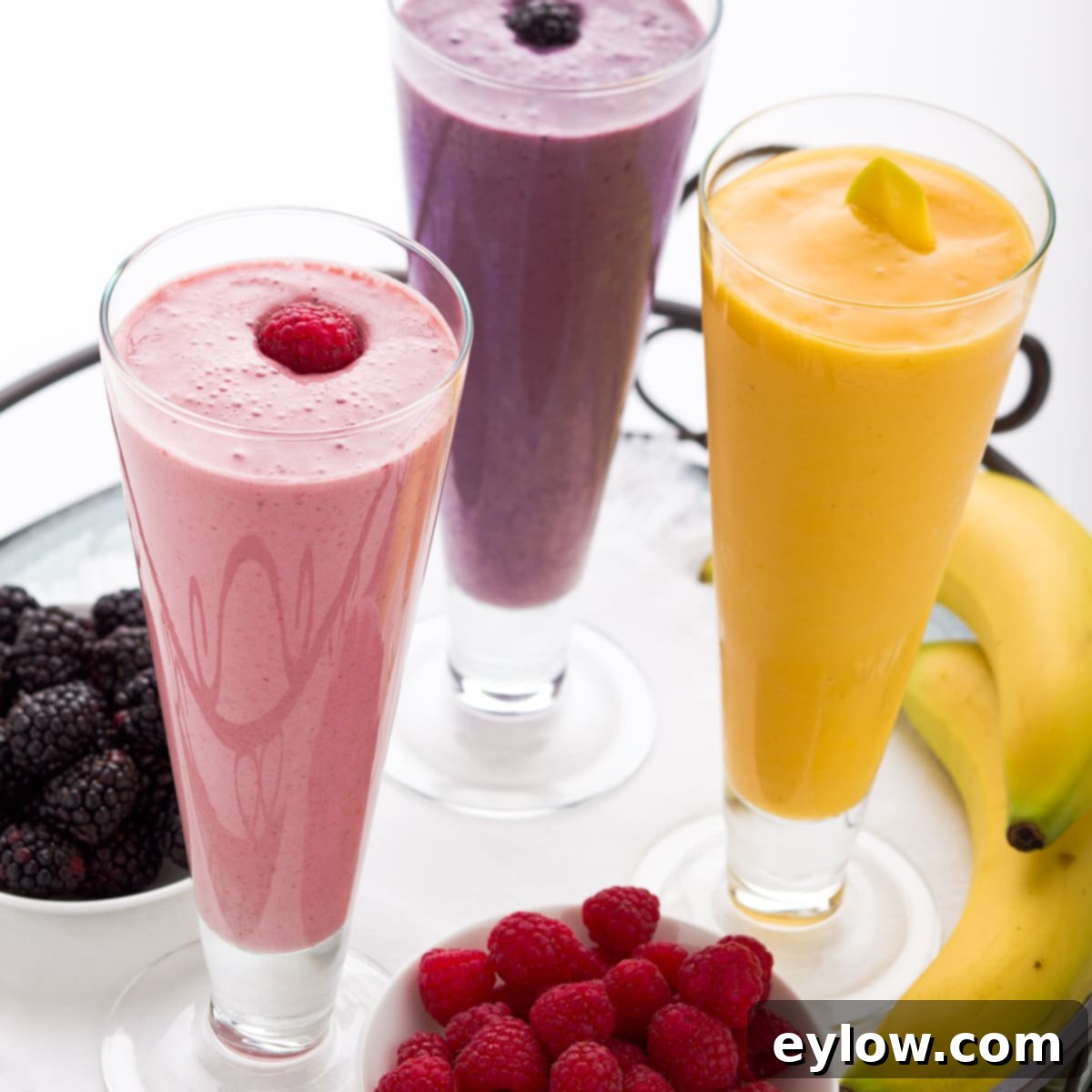The Ultimate Guide to Crafting Healthy Smoothies: Boost Your Wellness with Delicious Blends
Are you confused about how to create genuinely healthy and delicious smoothies that support your wellness goals? Look no further! As a professionally trained chef and certified health coach, with over 25 years of experience in developing and savoring countless smoothie recipes, I’ve sifted through a thousand options and combinations. This comprehensive guide distills my extensive knowledge, offering you clarity amidst the often-overwhelming world of smoothie ingredients. Making the best choices can be perplexing, but I’m here to simplify it for you. Don’t forget to download the PDF cheatsheet below for a quick reference!
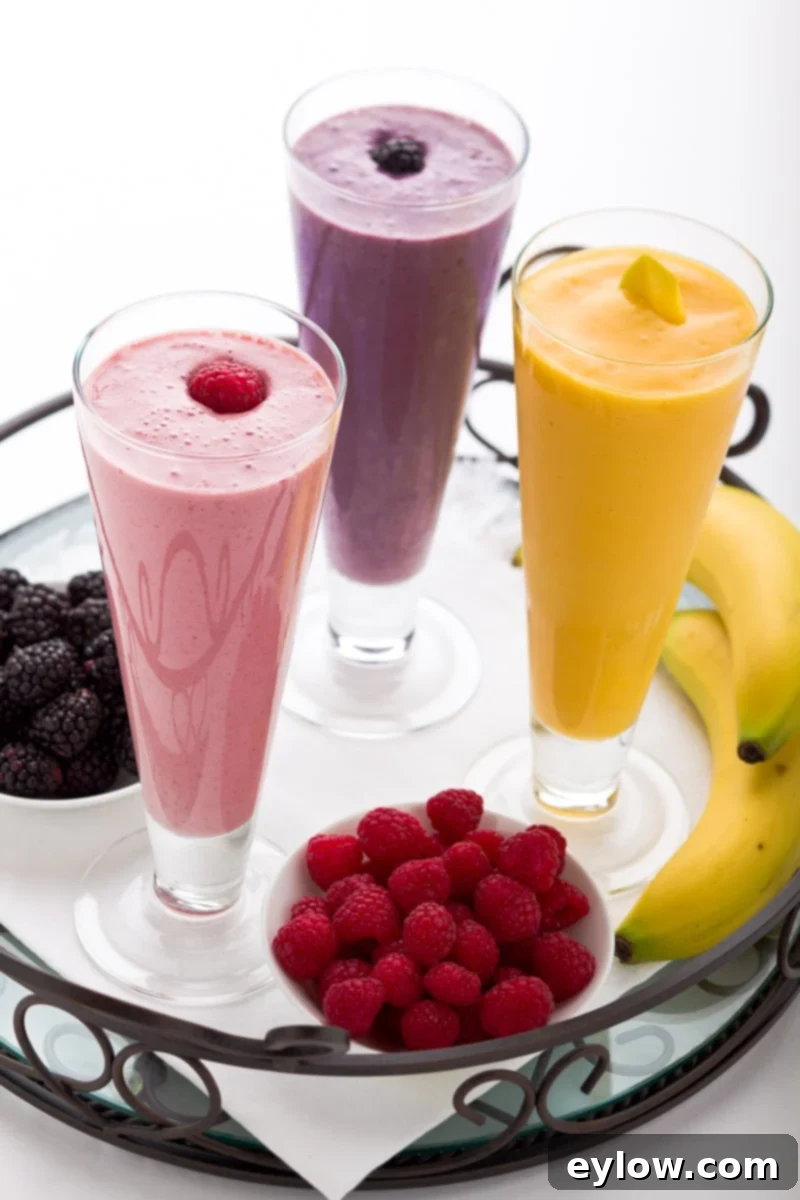
Smooth, creamy, and bursting with essential nutrition, healthy smoothies are a fantastic, convenient option for breakfast. They are incredibly customizable, allowing you to tailor them perfectly to your specific nutritional needs and taste preferences. Simply whirl your chosen ingredients together in a high-speed blender and enjoy a wholesome meal or snack in minutes.
In our household, these nutritious blends are a nearly daily ritual for breakfast. I’ve found that consistently incorporating smoothies into my diet leaves me feeling energized and balanced throughout the morning. They provide a substantial amount of protein and fiber right at the start of the day, setting a positive tone for overall well-being. If you’re seeking an excellent way to kickstart your day with a nutrient boost, these healthy protein smoothies are an ideal choice. They also serve as a quick, energizing power lunch or a perfect post-workout recovery drink.
Can Smoothies Actually Be Unhealthy? Understanding Smart Choices
The short answer is a resounding yes, smoothies can absolutely be unhealthy. While often perceived as a beacon of health, a smoothie’s nutritional value hinges entirely on its ingredients. It’s a common misconception that all blended drinks are inherently good for you. In reality, a smoothie can be a powerhouse of nutrition or a hidden sugar bomb, depending on your choices. Making truly healthy smoothies requires self-education to understand beneficial options and what components to consciously avoid.
Let me share a quick anecdote to illustrate this point. I was once working at a food fair, promoting healthy eating. A gentleman approached my table, beaming with pride as he described his daily “incredible smoothie.” He detailed its composition with great enthusiasm, which, among other things, included a large assortment of high-sugar fruits. His wife, standing nearby, rolled her eyes and quietly walked away – a clear sign that perhaps not all was as it seemed. After he finished, he eagerly asked for my professional opinion. I had to be honest with him. His “healthy” concoction was, in fact, a massive sugar bomb, far from the nutritious meal he believed it to be. He was genuinely surprised at first, but as we discussed the sugar content of his chosen fruits and the lack of balancing ingredients, he began to understand. He left armed with crucial information to transform his smoothie into a genuinely healthier option.
Tip #1: Select the Perfect Base Liquid for Your Smoothie
The foundation of any great healthy smoothie recipe is the right base liquid. This choice significantly impacts both the taste and nutritional profile. Here are some excellent options to consider:
- Homemade almond milk is always a top-tier choice. When using it for smoothies, I personally don’t strain mine. Why discard that delicious, healthy almond pulp and its valuable fiber? If you’re making it for other recipes that require a smoother, more fluid milk, then straining with a nut milk bag to remove solids is appropriate. For store-bought varieties, whether boxed or refrigerated, always read the labels meticulously to avoid added sugars, artificial flavors, and unwanted additives.
- Cashew milk: Another incredibly easy and creamy milk to prepare at home. Here’s my go-to recipe for homemade cashew milk. It offers a wonderfully smooth texture.
- Coconut Milk: Provides a rich, creamy texture and a delightful flavor. It’s surprisingly easy to make in just a minute using canned organic coconut milk. Skip the overly processed, store-bought “coconut beverages” that often contain unnecessary fillers and less actual coconut.
- Oat milk: A popular plant-based option. As with almond milk, vigilance is key – carefully read labels for a truly clean oat milk (some excellent unsweetened options are available in the refrigerated section), or consider making your own at home to control ingredients fully.
- Hemp milk: Many shelf-stable brands contain gums and various additives. For a purer, more nutritious version, try making homemade hemp milk. It costs mere pennies to produce (in about 1 minute!) using organic hemp seeds and boasts an impressive protein content.
- Coconut water: A hydrating option, but be selective. Look for brands with the lowest natural sugar content or those explicitly labeled “no sugar added.”
- Water: For the absolute cleanest and most neutral option, simply use filtered water. It allows the flavors of your other smoothie ingredients to shine through.
You might also wonder about two other common “milks”: soy milk and rice milk. Soy, and consequently soy milk, is a controversial ingredient with ongoing debates surrounding its health benefits and potential drawbacks. On the positive side, it’s known for being high in protein. However, a significant negative is that soy is a common food allergen or sensitivity, causing digestive upset for many individuals. Soy contains phytoestrogens (plant-based estrogens) which can mimic human hormones, potentially leading to disruptions. As is often the case in nutrition, studies present conflicting conclusions. The good news is that with so many other healthy alternatives available, you have plenty of choices. If you do enjoy soy milk, always ensure you purchase an organic, non-GMO variety.
What about rice milk? The primary concern with store-bought rice milk stems from the fact that rice plants naturally absorb arsenic from the soil as they grow. This means rice and rice-based products can contain detectable levels of this toxic metal. Tests conducted by Consumer Reports have indicated that many commercial rice products contain arsenic at worrisome concentrations. As someone who has personally dealt with heavy metal toxicity, this issue is a significant concern for me.
Chef’s Note: If, like us, you enjoy rice, there’s a specific cooking method that can significantly reduce its arsenic content. Here’s how to cook rice to minimize natural arsenic levels.
Consider the convenience and quality of making your own coconut milk using organic canned coconut milk. It boasts a fantastic taste, is always readily available in the pantry, and allows you to customize the consistency by using it half and half with water or adjusting the water ratio to meet your dietary requirements. Looking for another unique and fun option? Give homemade pumpkin seed milk a try – it features a lovely pale green hue and a distinct nutty flavor.
Always be sure to read labels meticulously when purchasing any type of milk. Opt for unsweetened, unflavored varieties to actively avoid unnecessary added sugars and unwelcome additives like carrageenan, a thickener that can cause digestive issues for some. If you select a flavored milk, ensure it’s flavored with real, identifiable ingredients, as something vaguely labeled “natural flavor” may contain components that are far from natural or beneficial.
Healthline reports in this insightful article that “the original source of natural flavors must be plant or animal material. However, natural flavors can be highly processed and contain many chemical additives. In fact, in some cases natural flavors aren’t much different from artificial flavors in terms of chemical composition and health effects.” This is definitely something to ponder when making your ingredient choices.
Chef’s Note: About almonds. Almond growers have sometimes faced scrutiny regarding the water usage required to cultivate almonds. If this is a concern for you, but you still love almonds, I highly recommend reading this informative article about sustainable almond farming practices. It offers valuable perspective and insights into the industry’s efforts.
Tip #2: Power Your Smoothies with Protein
Incorporating sufficient protein into your breakfast (and indeed, all your meals) is a cornerstone of good health. Protein plays a crucial role in curbing hunger, maintaining balanced blood sugar levels, and significantly reducing cravings throughout the day. It helps you feel full and satisfied for longer, preventing energy crashes and unhealthy snacking. So, let’s delve into the world of protein for your healthy smoothies: Should you use protein powder or not? And what about animal versus plant-based options?
Tip #3: Selecting the Ideal Protein Source for Your Needs
The landscape of protein powder options has dramatically improved over the years. What used to be a fairly dismal selection with questionable ingredients now offers an amazing array of high-quality choices. The main challenge today lies in navigating these numerous options to find the perfect one (or ones) that align with your dietary preferences, allergies, and health goals.
The market is saturated with protein powder choices, ranging from traditional animal-based options like whey (derived from cow and goat milk) and egg white protein, to an excellent and expanding variety of plant-based and vegan alternatives. These include brown rice protein, almond protein, pea protein, and even specialized options like pumpkin seed protein, along with collagen peptides which offer unique benefits.
Chef Sally’s tip: For individuals with nut allergies, exercise caution when purchasing products that include hemp or pea protein in the blend. While not tree nuts, they can sometimes trigger cross-reactions or sensitivities in those allergic to peanuts, as they belong to the same botanical family.
When selecting a protein supplement powder, always prioritize reading the labels carefully. Be on the lookout for hidden or added sugars, artificial additives, unnecessary fillers, and excessively high sodium content. For more in-depth guidance, read this comprehensive article on how to choose a protein powder. Beyond powders, here’s a quick list of excellent non-powder protein options to boost your smoothies:
- Greek yogurt: This is a superb protein source. Greek yogurt contains significantly more protein than regular yogurt due to the straining process used in its creation. Always opt for plain, unsweetened varieties to keep sugar levels minimal. Unfortunately, most plant-based yogurts currently on the market are primarily fat-based with very little, if any, protein content.
- Seeds: Hemp hearts (also known as hemp seeds) are exceptionally high in protein and healthy fats, offering a pleasant nutty flavor. Other seeds like flax seeds and chia seeds also contribute a small but meaningful amount of protein, and these small contributions can quickly add up to a substantial boost.
- Nut butters: Almond butter, cashew butter, or even peanut butter (if no allergies) are fantastic for adding both protein and beneficial healthy fats, alongside a rich, creamy texture.
Ensuring You Get Enough Protein for Optimal Health
Official protein recommendations typically suggest a minimum of 46 grams per day for women and 56 grams per day for men. However, these figures are generally considered a baseline minimum and often fall short of what’s truly needed for optimal health and satiety. A more personalized approach is to calculate your protein needs by multiplying your weight in pounds by 0.36 (or 0.8 grams per kilogram of body weight). Many individuals, however, may require higher levels.
If you lead an active lifestyle, participate in regular athletic training or sports, are pregnant, or are over 70, your protein requirements will be considerably higher. Current scientific studies increasingly indicate that the protein needs for maintaining muscle mass, supporting metabolism, and achieving overall optimal health are greater than previously thought.
Personally, I aim for a minimum of half my body weight in grams of protein per day (around 63 grams for me), with a real target closer to 90-100 grams, especially on days when I engage in strength training. I’ve cross-referenced these numbers with my personal trainer, and he confirms that this range is effective for my goals. It’s important to find what works best for your body and your lifestyle. Experiment to observe where you feel your most energetic and satisfied. If you’re still contemplating your ideal protein intake, here are 10 science-backed reasons why increasing your protein consumption is a beneficial idea.
Tip #4: Incorporate Healthy Fats for Enhanced Flavor and Nutrition
Why is it beneficial to add healthy fats to your smoothies? There are several compelling reasons. Firstly, fat is a carrier of flavor, meaning that a touch of healthy fat will make your smoothies taste richer and more satisfying. Beyond taste, healthy fats are absolutely essential for the absorption of fat-soluble vitamins, including vitamins A, D, E, and K. Without adequate fat, your body simply cannot utilize these vital nutrients from your fruits and vegetables. Don’t fear healthy fat; our bodies not only need it but thrive on it for hormone production, brain health, and overall cellular function. For terrific healthy fat add-ins for your nutritious smoothies, consider:
- Avocado: Adds incredible creaminess and a wealth of monounsaturated fats.
- Coconut oil or MCT oil: Provides quick energy and can support brain function. Pure C8 MCT oil is often preferred for its effectiveness and neutral flavor.
- Nut and Seed Butters: Almond butter, cashew butter, or even a spoonful of rich coconut butter contribute healthy fats, protein, and a luxurious texture.
- Ground flaxseed: A fantastic source of Omega-3 fatty acids and fiber. Ensure it’s freshly ground for maximum benefit.
- Hemp seeds (hemp hearts): Packed with Omega-3s, Omega-6s, and protein.
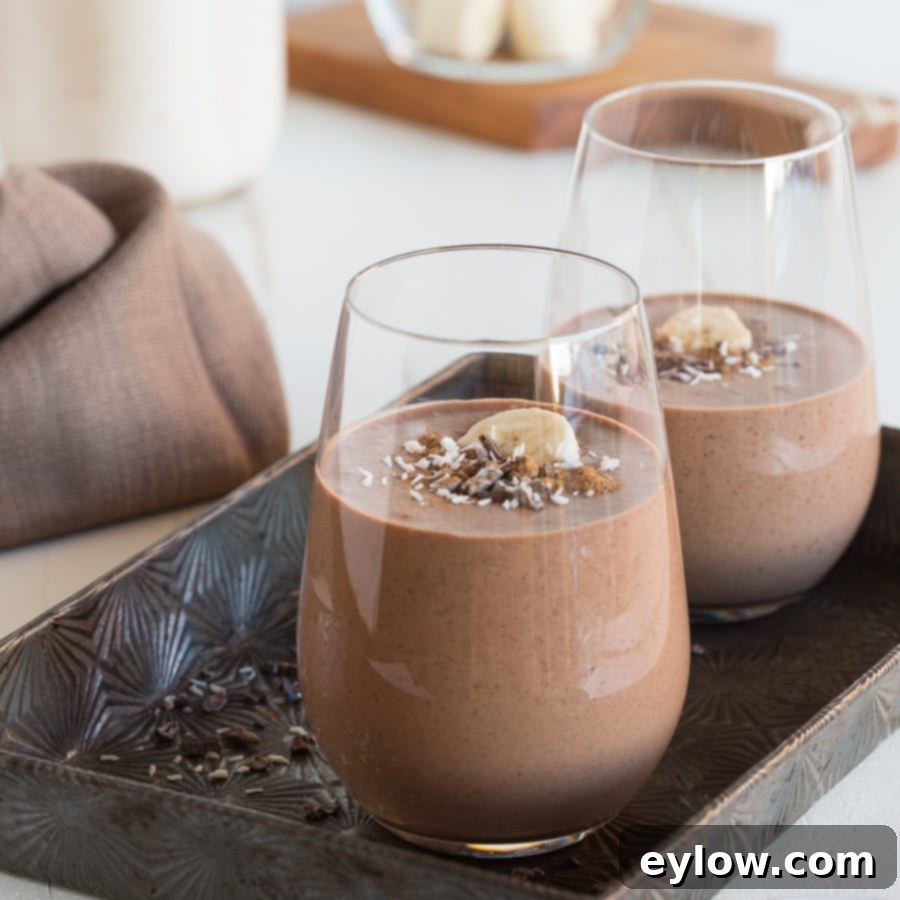
Tip #5: Enhance Your Smoothie with Nutrient-Rich Fruits and Vegetables
Embrace the Power of Phytonutrients
The vibrant colors and rich aromas of fruits and vegetables contribute far more than just visual appeal and basic nutrition to your smoothies. These characteristics are due to phytonutrients: natural plant compounds that imbue plants with their distinct colors, flavors, and potent health benefits. Harvard Health reports that “phytonutrients have potent anti-cancer and anti-heart disease effects,” playing a crucial role in protecting your body against various diseases. The clear takeaway here is to generously incorporate a diverse range of fruits and vegetables into your healthy smoothie recipes.
Optimal Fresh and Frozen Fruit Choices
When it comes to fruit, both fresh and frozen options work wonderfully. For optimal health benefits, prioritize low-sugar berries like blueberries, raspberries, blackberries, and strawberries. These are all fantastic choices for healthy protein smoothies, offering a wealth of antioxidants without excessive natural sugars. Aim for about a half-cup serving of berries.
Also consider unsweetened frozen acai berry smoothie packets and unsweetened dragon fruit puree packets. Dragon fruit, with its wild fuchsia color, not only looks amazing but signals a rich concentration of beneficial phytonutrients – all that vibrant color is a testament to its goodness!
Prioritize Low-Sugar Fruits for Balanced Smoothies
Beyond berries, there are several other excellent low-sugar fruit options that are perfect for your smoothies. These include kiwi, grapefruit, watermelon, peaches, honeydew, and cantaloupe. Interestingly, cucumber is botanically classified as a fruit, and it’s a refreshingly low-sugar addition that also boosts hydration.
Mindful Use of Higher Sugar Fruits
If you enjoy higher-sugar fruits like pineapple, mango, and banana, it’s important to be mindful of the quantity you use to prevent your smoothie from becoming a sugar overload. If these are included, ensure you absolutely do not add any additional sweeteners to the recipe. For bananas, opt for greenish ones, as they contain less sugar and more resistant starch compared to fully ripe, spotty bananas. This is where a digital kitchen scale becomes an invaluable tool. You can check the nutritional information on package labels (or look up fresh fruit data) and precisely weigh your fruit portions to effectively manage your sugar intake. While natural fruit sugar isn’t “added sugar,” it still contributes to your overall sugar consumption and caloric intake.
Chef Sally’s tip: Many people adore bananas in smoothies because they provide a wonderful creamy texture. However, bananas are among the higher-sugar fruits. My banana tip: select a greenish banana, as they are lower in sugar and offer beneficial resistant starch. Alternatively, use only half a banana. To achieve sweetness without added sugar, consider using monk fruit extract or stevia, which provide sweetness without impacting blood sugar levels.
Incorporate a Variety of Vegetables and Greens
For savory veggie additions, a generous handful of baby spinach leaves or baby kale leaves are excellent ways to boost your greens intake subtly. Chopped raw beets are not only packed with nutrients but will also transform your smoothie into a gorgeously vibrant, deep red or purple color. Other great vegetable options include frozen cauliflower (which adds creaminess without altering flavor much), grated carrot for a touch of sweetness and vitamins, or chopped cucumber for freshness and hydration.
While botanically a fruit, pumpkin is functionally often used as a vegetable and is fantastic in smoothies, especially during the fall season, bringing a comforting flavor and a wealth of vitamin A.
Tip #6: Prioritize Dietary Fiber for Digestive Health
Your mother was right when she told you to eat your roughage! Dietary fiber is incredibly important for numerous aspects of health, yet the standard American diet is notoriously deficient in it. Fiber plays a vital role in keeping your gut microbiome healthy and happy, supporting effective weight management, and significantly protecting against cardiovascular disease. It helps regulate blood sugar, promotes regularity, and contributes to satiety.
Achieving the recommended daily intake of 25-35 grams of fiber is a challenge for many individuals. Fortunately, adding fiber to your healthy smoothies is remarkably easy and often goes unnoticed in terms of taste or texture.
We routinely incorporate a teaspoon of acacia powder into our smoothies to effortlessly boost fiber content. It dissolves seamlessly into the smoothie, becoming completely undetectable. An added benefit is that acacia fiber acts as a prebiotic, which means it feeds the beneficial bacteria in your gut. As the Cleveland Clinic explains, “Prebiotics support a healthy gut microbiome,” fostering a thriving internal ecosystem.
Another excellent fiber-rich addition is ground flaxseed. For the best nutritional impact and to ensure maximum absorption of its omega-3 fatty acids, it’s ideal to grind 2 tablespoons of whole flaxseeds fresh, just before adding them to your smoothie. A small coffee or spice grinder works perfectly for this. If grinding fresh isn’t feasible or convenient for you, opt for cold-milled pre-ground flaxseed from a reputable brand like this one, and store it in the refrigerator to preserve its freshness.
Tip #7: Smart Sweetening Options for Your Smoothies
When it comes to sweetening your healthy smoothies in a smart and health-conscious way, there are several excellent choices that avoid excessive sugar. Consider adding granulated monk fruit extract, a small amount of raw honey, pure maple syrup, brown rice syrup, or a pitted chopped date. The monk fruit option provides the ultimate low-sugar solution, as it contains virtually no sugar and zero calories, making it ideal for those closely monitoring their sugar intake.
Even better, explore these sugar-free monk fruit-based syrups. They are absolutely fantastic and come in a variety of delicious flavors, as well as a plain, unflavored option. These have become my personal healthy go-to sweeteners for smoothies and many other recipes, allowing for delicious taste without the sugar spike.

Tip #8: Maximize Nutrition with Superfood Power Add-ons
Even with just the foundational ingredients we’ve discussed so far, you can create a truly healthy and satisfying smoothie. However, if you’re looking to elevate your smoothie’s nutritional density and provide an extra boost of wellness, consider incorporating these powerful superfood supplements. They are packed with concentrated nutrients and offer unique health benefits:
- Acai Powder: This small, dark purple Amazonian berry (pronounced ah-SIGH-ee) is a nutritional powerhouse. It delivers exceptional amounts of antioxidants, beneficial omega fats, protein, and fiber. Acai is renowned for boosting immunity and enhancing energy levels. While powder is great, we now often use frozen acai packets, which are widely available at most grocery stores.
- Omega-3 Fish Oil: We opt for a high-potency brand with a subtle lemon flavor. It blends seamlessly into your smoothie, leaving no trace of a fishy taste (unlike some lower-quality oils). Always store fish oil in the freezer to maintain its freshness and potency.
- Raw Organic Cacao Powder: Not to be confused with cocoa, raw cacao is an incredible superfood. It’s a top source of antioxidants, magnesium, and iron, along with other essential vitamins, minerals, and even a modest amount of protein and fiber. It adds a delicious chocolatey flavor too!
- Chia Seeds: These tiny seeds are a fantastic source of healthy omega fats, plant-based protein, powerful antioxidants, and abundant dietary fiber. Chia seeds have a neutral flavor and, due to their ability to absorb many times their weight in water, they naturally thicken liquids, giving your smoothie a lovely consistency.
- Maca Powder: Maca is an adaptogen, a natural substance that works synergistically with your body to help manage stress and promote energy balance. This ancient Peruvian superfood was highly valued by Incan warriors for its ability to increase stamina and combat fatigue. For more insights into adaptogens, explore this article.
- Pomegranate Powder: While the fresh fruit is delicious and nutritious, adding pomegranate powder to your smoothies offers a concentrated boost. It’s known for its immune-boosting properties, abundant antioxidants, and potential benefits for heart health.
- Pure MCT Oil: A source of healthy fats that serves as excellent brain fuel, providing quick, sustained energy. You can choose a general MCT blend or opt for pure C8 oil, which is highly effective. It has zero coconut flavor, and just 1 tablespoon is sufficient to reap its benefits.
- Maqui (mah-kee) Berry Powder: This delicious, deep purple freeze-dried powder comes from the Patagonia region of southern Chile and is a powerhouse of antioxidants, particularly beneficial for cellular health.
- Tart Cherry Powder: Evidence from published reports indicates that cherries can help support lower oxidative stress, reduce inflammation, and alleviate exercise-induced muscle soreness. Plus, they add a delightful tangy flavor.
- Spirulina: Often hailed as nature’s original superfood, spirulina is a blue-green microalgae brimming with a wide array of health benefits, including potent antioxidant and anti-inflammatory properties.
- Creatine: Creatine is an amino acid best known for its significant muscle-supporting benefits, and it’s certainly not just for bodybuilders! While your body naturally produces creatine, the amount is often not optimal for building or maintaining muscle mass, especially as we age. I personally add it to my smoothies every day to support my fitness goals. Learn more about the comprehensive benefits of creatine here.
While these extra superfood additions may initially seem like a pricey investment, I firmly believe they are well worth it due to the substantial nutritional boost they provide. When broken down, incorporating them truly costs just pennies a day for enhanced well-being.
Chef Sally’s Tip: Why Powders? Nutritional powders offer a higher concentration of beneficial compounds, facilitate quicker absorption by the body upon ingestion, and are typically gentle on the stomach. Furthermore, they make it incredibly easy to vary the flavors and health benefits of your smoothies, allowing for endless customization and experimentation.
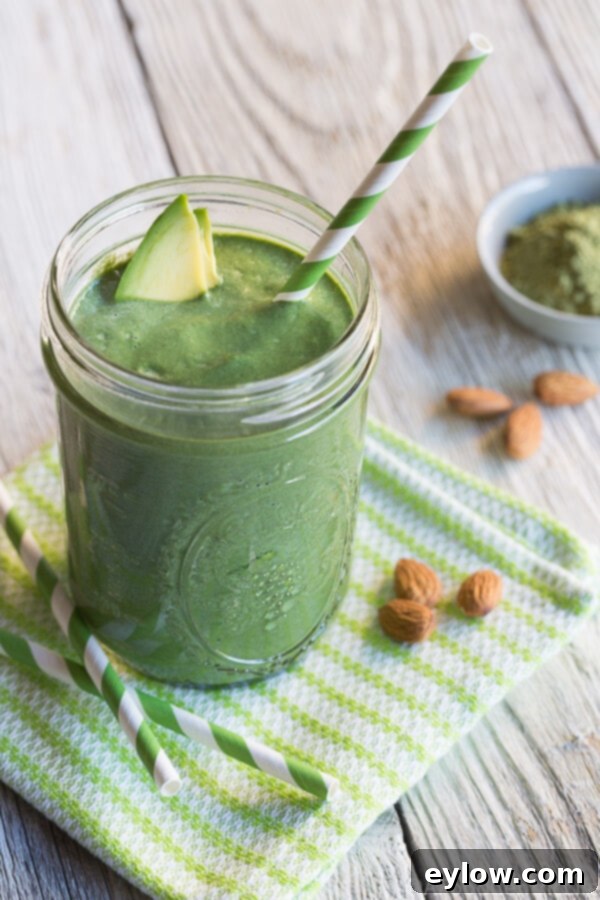
Frequently Asked Questions About Healthy Smoothies
Creating a delicious dairy-free smoothie is incredibly simple and offers many creative options. Begin with a plant-based liquid base such as unsweetened almond milk, coconut milk, oat milk, or homemade cashew milk. For protein, choose a high-quality plant-based protein powder (like pea, rice, or hemp protein) or egg white protein powder. Make sure to avoid whey-based protein powders and any recipes that use traditional dairy yogurt as a primary protein source. With these mindful substitutions, making delicious and wholesome dairy-free smoothies is a breeze.
Smoothies don’t have to be sugar-laden; their sugar content is entirely dependent on your recipe and ingredient choices. They can easily become “sugar bombs” if you’re not careful, often due to excessive amounts of high-sugar fruits or added sweeteners. To keep your smoothies low in sugar or entirely sugar-free, prioritize low-sugar fruits like berries, utilize natural zero-calorie sweeteners such as monk fruit or stevia, and always select unflavored, unsweetened liquid bases and protein powders.
Achieving a wonderfully creamy smoothie texture is easy with a few tricks. Try adding half of a barely ripe banana (as mentioned, green bananas are lower in sugar), a tablespoon or two of your favorite nut butter, or even a quarter of an avocado for unparalleled richness. Incorporating just a couple of ice cubes can also help make the smoothie silkier and perfectly chilled. If your smoothie turns out too thin or fluid, simply reduce the amount of liquid or opt for a naturally creamier base liquid next time. Adding a scoop of Greek yogurt is another excellent way to boost creaminess while simultaneously providing a good dose of quality protein.
Yes, smoothies can be a highly effective component of a healthy eating and weight management program, provided you make smart ingredient choices. The key is to be extremely careful and intentional about what goes into your blender. Focus on low-sugar fruits, such as a generous serving of frozen berries. Choose unsweetened plant-based milks like almond milk or unsweetened hemp milk. Avoid high-sugar sweeteners and instead use monk fruit or stevia. Incorporate plenty of vegetables, such as a handful of spinach leaves or a bit of frozen cauliflower, to boost fiber and nutrients. The simpler and cleaner your ingredient list, the better your smoothie will support your weight loss goals.
Explore More Delicious Healthy Smoothie Recipes
No matter the season or your craving, I’ve got you covered with a variety of irresistible healthy smoothie recipes designed to nourish and delight. For a cozy autumn treat, our Pumpkin Pie Smoothie is absolutely fantastic and tastes just like dessert. If you’re looking to refresh and reset, a Green Detox Smoothie is always a staple on our menu, packed with cleansing ingredients. And for those mornings when you want a little indulgence with a powerful energy boost, dive into our rich Chocolate Maca Energy Smoothie – it’s like having dessert for breakfast, guilt-free!
- Pumpkin Smoothie (Healthy & Easy)
- Strawberry Yogurt Smoothie with Banana
- Green Smoothie Recipe with Mango
- Chocolate Blueberry Smoothie (high protein)
⭐️ Did This Guide Help You?
I hope this comprehensive guide has provided you with valuable insights into crafting truly healthy and delicious smoothies. Did you find the tips useful? Please share your thoughts and experiences in the comments section below. I genuinely appreciate your feedback and love hearing from you! If you found this article helpful, please consider giving it a 5-star rating – your ratings significantly help other readers discover and benefit from this content.
Originally published: January 8, 2012. Last updated: July 3, 2024.
📖 Recipe
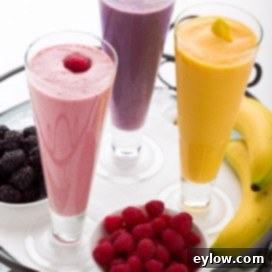
Basic Healthy Smoothie Recipe
Sally Cameron
Pin Recipe
Equipment
-
High-Speed Blender
Ingredients
Basic Healthy Smoothie
Core Ingredients
- 10 ounces unsweetened almond, cashew, oat, or hemp milk, or filtered water. Organic soy milk or homemade coconut milk are also excellent options.
- 1-2 scoops protein powder of choice
- ½ small greenish banana (optional, for creaminess and lower sugar)
- ½ cup frozen berries, mango, or cherries (choose 1 type of fruit)
- 1 teaspoon acacia fiber
- 1 tablespoon MCT or coconut oil (optional, for healthy fats)
- 1 teaspoon granular monk fruit or monk fruit syrup (no sugar). Alternatively, use flavored liquid stevia, a small amount of honey, maple syrup, or a pitted date.
Instructions
-
Combine all ingredients in a high-speed blender. Blend until completely smooth and creamy. Serve immediately and enjoy! If the smoothie is too thick for your preference, add a little more milk or water, one tablespoon at a time, until it reaches your desired consistency.
Notes
For a powerful nutritional boost and a wider array of ingredient options, refer back to the main article on “Superfood Power Add-ons.”
